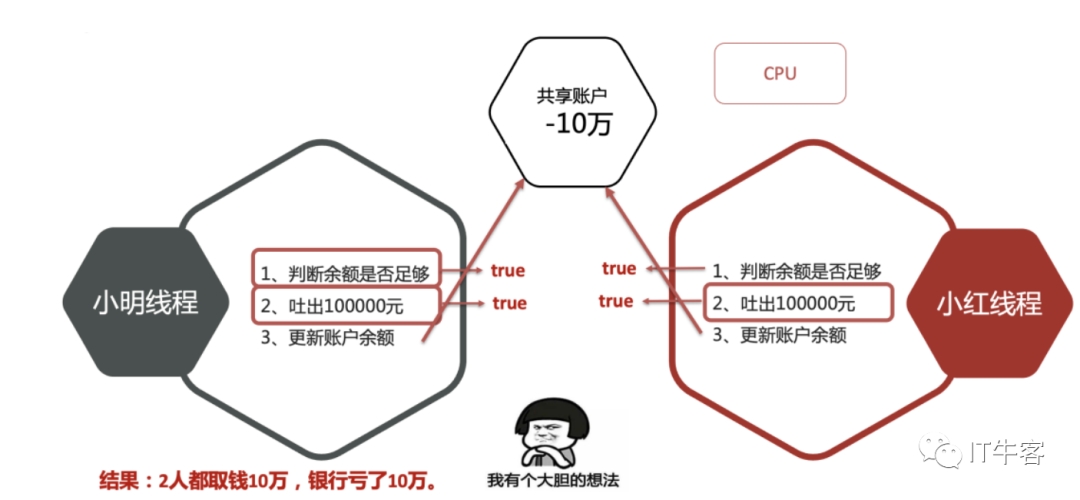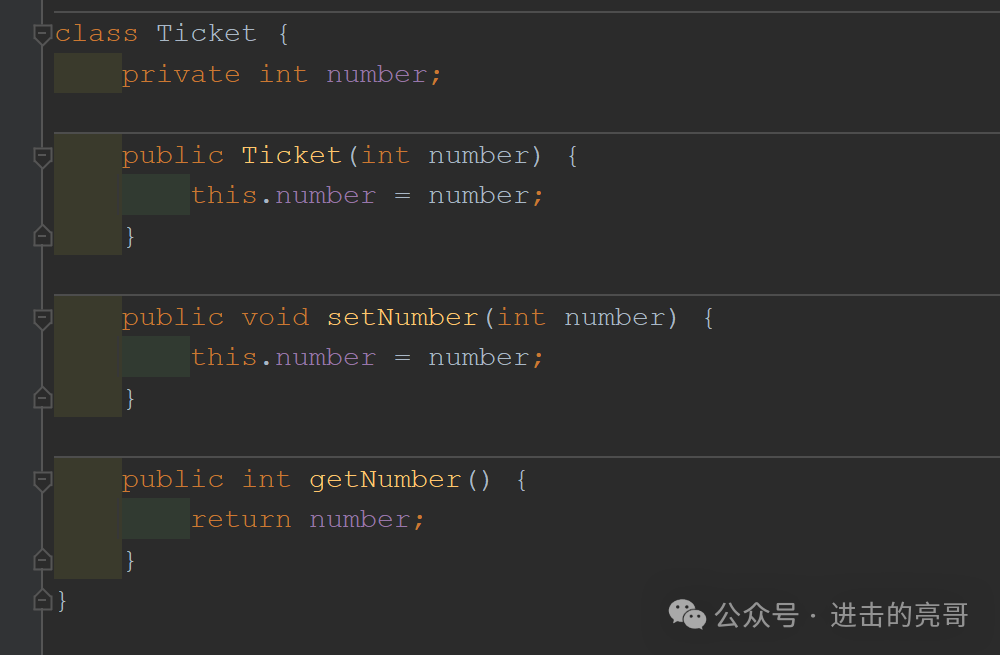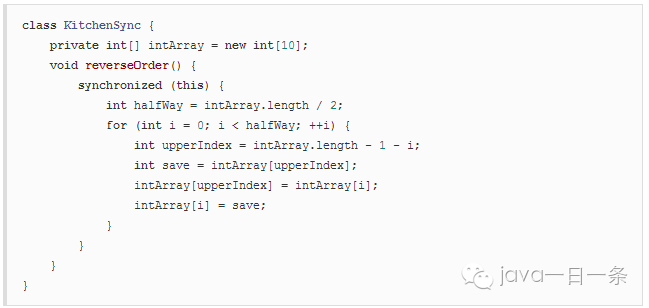大家好,我是老三,这篇文章分享一道非常不错的题目:三个线程按序打印ABC。
很多读者朋友应该都觉得这道题目不难,这次给大家带来十二种做法,一定有你没有见过的新姿势。
1. synchronized+wait+notify
说到同步,我们很容易就想到synchronized。
线程间通信呢?我们先回忆一下线程间的调度。
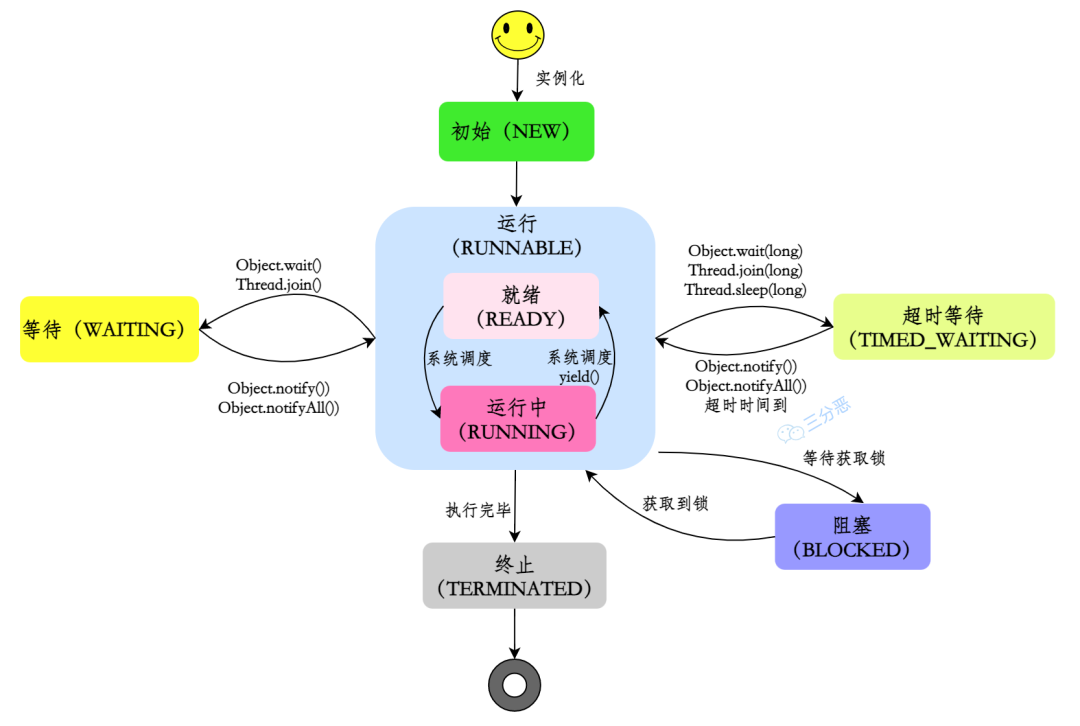
多线程常见调度方法
可以看到,等待和运行之间的转换可以用wait和notify。
那么整体思路也就有了:

ABC-1
public class ABC1 {
//锁住的对象
private final static Object lock = new Object();
//A是否已经执行
private static boolean aExecuted = false;
//B是否已经执行过
private static boolean bExecuted = false;
public static void printA() {
synchronized (lock) {
System.out.println("A");
aExecuted = true;
//唤醒所有等待线程
lock.notifyAll();
}
}
public static void printB() throws InterruptedException {
synchronized (lock) {
//获取到锁,但是要等A执行
while (!aExecuted) {
lock.wait();
}
System.out.println("B");
bExecuted = true;
lock.notifyAll();
}
}
public static void printC() throws InterruptedException {
synchronized (lock) {
//获取到锁,但是要等B执行
while (!bExecuted) {
lock.wait();
}
System.out.println("C");
}
}
}
@Test
void abc1() {
//线程A
new Thread(() -> {
ABC1.printA();
}, "A").start();
//线程B
new Thread(() -> {
try {
ABC1.printB();
} catch (InterruptedException e) {
e.printStackTrace();
}
}, "B").start();
//线程C
new Thread(() -> {
try {
ABC1.printC();
} catch (InterruptedException e) {
e.printStackTrace();
}
}, "C").start();
}
2. lock+全局变量state
还可以用lock+state来实现,大概思路:
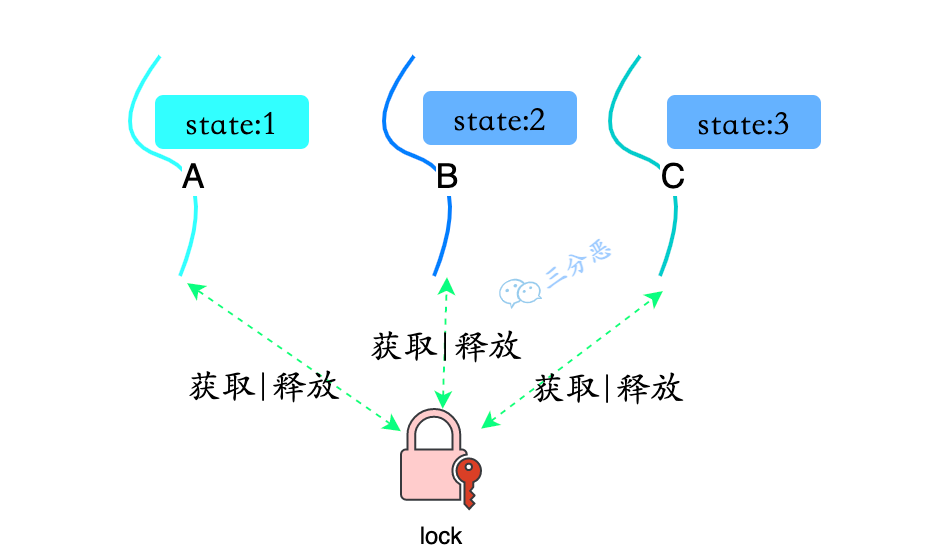
lock+state
public class ABC2 {
//可重入锁
private final static Lock lock = new ReentrantLock();
//判断是否执行:1表示应该A执行,2表示应该B执行,3表示应该C执行
private static int state = 1;
public static void printA() {
//自旋
while (state < 4) {
try {
//获取锁
lock.lock();
//并发情况下,不能用if,要用循环判断等待条件,避免虚假唤醒
while (state == 1) {
System.out.println("A");
state++;
}
} finally {
//要保证不执行的时候,锁能释放掉
lock.unlock();
}
}
}
public static void printB() throws InterruptedException {
while (state < 4) {
try {
lock.lock();
//获取到锁,应该执行
while (state == 2) {
System.out.println("B");
state++;
}
} finally {
lock.unlock();
}
}
}
public static void printC() throws InterruptedException {
while (state < 4) {
try {
lock.lock();
while (state == 3) {
//获取到锁,应该执行
System.out.println("C");
state++;
}
} finally {
lock.unlock();
}
}
}
}
这里也有几个细节要注意:
3. volatile
上一种做法,我们用了同步+全局变量的方式,那么有没有什么更轻量级的做法?
我们可以直接用volatile修饰变量,volatile能保证变量的更改对所有线程可见。
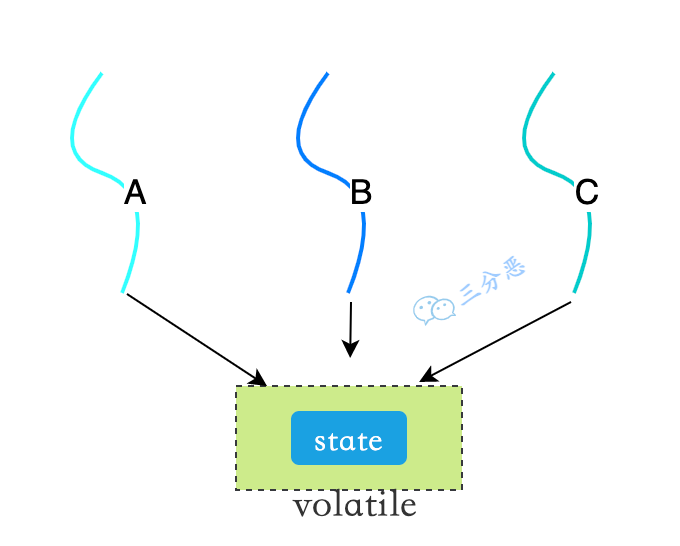
volatile
public class ABC3 {
//判断是否执行:1表示应该A执行,2表示应该B执行,3表示应该C执行
private static volatile Integer state = 1;
public static void printA() {
//通过循环,hang住线程
while (state != 1) {
}
System.out.println("A");
state++;
}
public static void printB() throws InterruptedException {
while (state != 2) {
}
System.out.println("B");
state++;
}
public static void printC() throws InterruptedException {
while (state != 3) {
}
System.out.println("C");
state++;
}
}
4. AtomicInteger
除了无锁的volatile方法,还有没有什么轻量级锁的方法呢?
我们都知道synchronized和lock都属于悲观锁,我们还可以用乐观锁来实现。
在Java里,我们熟悉的原子操作类AtomicInteger就是基于CAS实现的,可以用来保证Integer操作的原子性。
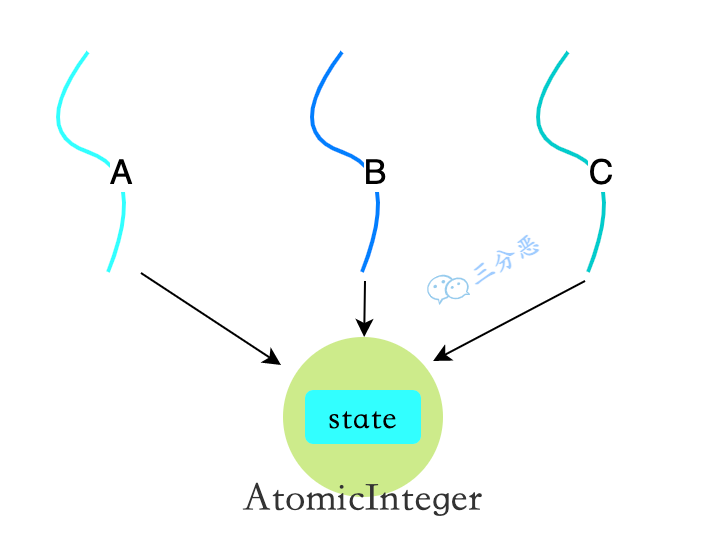
AtomicInteger
public class ABC4 {
//判断是否执行:1表示应该A执行,2表示应该B执行,3表示应该C执行
private static AtomicInteger state = new AtomicInteger(1);
public static void printA() {
System.out.println("A");
state.incrementAndGet();
}
public static void printB() throws InterruptedException {
while (state.get() < 4) {
while (state.get() == 2) {
System.out.println("B");
state.incrementAndGet();
}
}
}
public static void printC() throws InterruptedException {
while (state.get() < 4) {
while (state.get() == 3) {
System.out.println("C");
state.incrementAndGet();
}
}
}
}
5.lock+condition
在Java中,除了Object的wait和notify/notify可以实现等待/通知机制,Condition和Lock配合同样可以完成等待通知机制。
使用condition.await(),使当前线程进入等待状态,使用condition.signal()或者condition.signalAll()唤醒等待线程。
public class ABC5 {
//可重入锁
private final static Lock lock = new ReentrantLock();
//判断是否执行:1表示应该A执行,2表示应该B执行,3表示应该C执行
private static int state = 1;
//condition对象
private static Condition a = lock.newCondition();
private static Condition b = lock.newCondition();
private static Condition c = lock.newCondition();
public static void printA() {
//通过循环,hang住线程
while (state < 4) {
try {
//获取锁
lock.lock();
//并发情况下,不能用if,要用循环判断等待条件,避免虚假唤醒
while (state != 1) {
a.await();
}
System.out.println("A");
state++;
b.signal();
} catch (InterruptedException e) {
e.printStackTrace();
} finally {
//要保证不执行的时候,锁能释放掉
lock.unlock();
}
}
}
public static void printB() throws InterruptedException {
while (state < 4) {
try {
lock.lock();
//获取到锁,应该执行
while (state != 2) {
b.await();
}
System.out.println("B");
state++;
c.signal();
} finally {
lock.unlock();
}
}
}
public static void printC() throws InterruptedException {
while (state < 4) {
try {
lock.lock();
while (state != 3) {
c.await();
}
//获取到锁,应该执行
System.out.println("C");
state++;
} finally {
lock.unlock();
}
}
}
}
6.信号量Semaphore
线程间同步,还可以使用信号量Semaphore,信号量顾名思义,多线程协作时完成信号传递。
使用acquire()获取许可,如果没有可用的许可,线程进入阻塞等待状态;使用release释放许可。
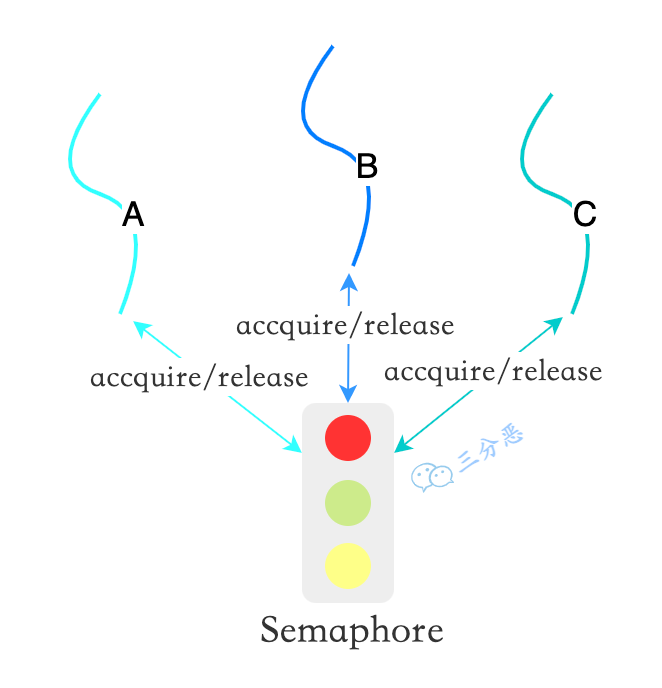
Semaphore
public class ABC6 {
private static Semaphore semaphoreB = new Semaphore(0);
private static Semaphore semaphoreC = new Semaphore(0);
public static void printA() {
System.out.println("A");
semaphoreB.release();
}
public static void printB() throws InterruptedException {
semaphoreB.acquire();
System.out.println("B");
semaphoreC.release();
}
public static void printC() throws InterruptedException {
semaphoreC.acquire();
System.out.println("C");
}
}
7.计数器CountDownLatch
CountDownLatch的一个适用场景,就是用来进行多个线程的同步管理,线程调用了countDownLatch.await()之后,需要等待countDownLatch的信号countDownLatch.countDown(),在收到信号前,它不会往下执行。
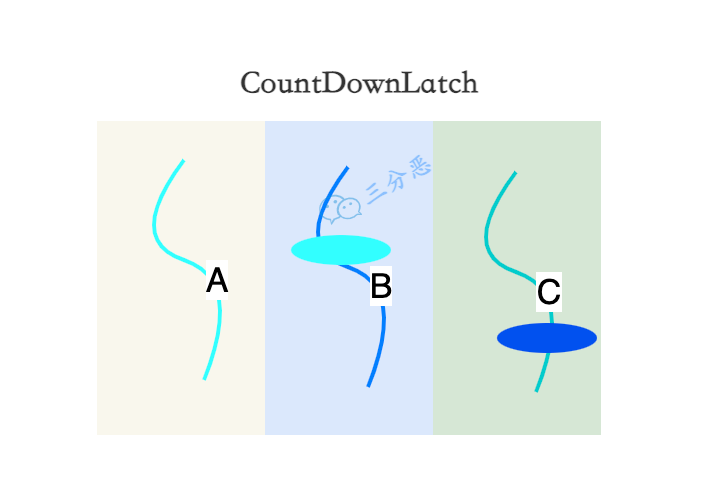
CountDownLatch
public class ABC7 {
private static CountDownLatch countDownLatchB = new CountDownLatch(1);
private static CountDownLatch countDownLatchC = new CountDownLatch(1);
public static void printA() {
System.out.println("A");
countDownLatchB.countDown();
}
public static void printB() throws InterruptedException {
countDownLatchB.await();
System.out.println("B");
countDownLatchC.countDown();
}
public static void printC() throws InterruptedException {
countDownLatchC.await();
System.out.println("C");
}
}
8. 循环栅栏CyclicBarrier
用到了CountDownLatch,我们应该想到,还有一个功能和它类似的工具类CyclicBarrier。
有的翻译叫同步屏障,我觉得翻译成循环栅栏,更能体现它的功能特性。
就像是出去旅游,大家不同时间到了景区门口,但是景区疫情限流,先把栅栏拉下来,在景区里的游客走一批,打开栅栏,再放进去一批,走一批,再放进去一批……
这就是CyclicBarrier的两个特性,
这道题怎么用CyclicBarrier解决呢?

CyclicBarrier
public class ABC8 {
private static CyclicBarrier cyclicBarrier = new CyclicBarrier(1);
private static Integer state = 1;
public static void printA() {
while (state != 1) {
}
System.out.println("A");
state = 2;
}
public static void printB() throws InterruptedException {
try {
//在栅栏前等待
cyclicBarrier.await();
//state不等于2的时候等待
while (state != 2) {
}
System.out.println("B");
state = 3;
} catch (BrokenBarrierException e) {
e.printStackTrace();
}
}
public static void printC() throws InterruptedException {
try {
cyclicBarrier.await();
while (state != 3) {
}
System.out.println("C");
} catch (BrokenBarrierException e) {
e.printStackTrace();
}
}
}
当然,CyclicBarrier的实现其实还是基于lock+condition,多个线程在到达一定条件前await,到达条件后signalAll。
9.交换器Exchanger
在前面,我们已经用到了常用的并发工具类,其实还有一个不那么常用的并发工具类Exchanger,同样也可以用来解决这道题目。
Exchanger用于两个线程在某个节点时进行数据交换,在这道题里:
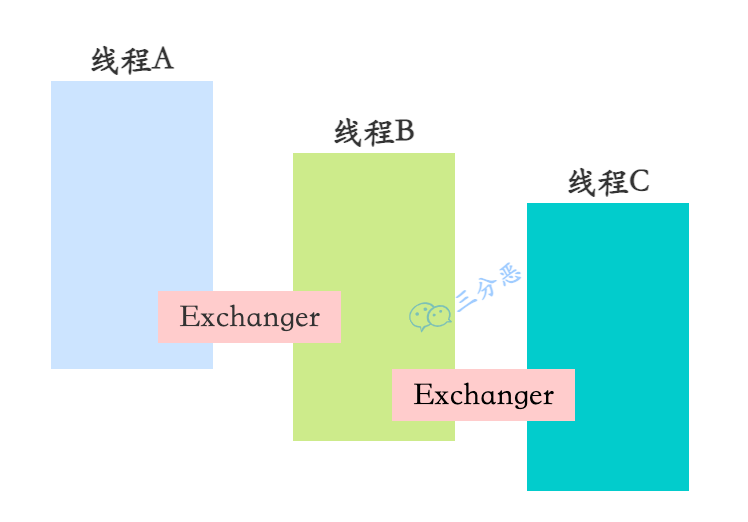
Exchanger
public class ABC9 {
private static Exchanger exchangerB = new Exchanger();
private static Exchanger exchangerC = new Exchanger();
public static void printA() {
System.out.println("A");
try {
//交换
exchangerB.exchange(2);
} catch (InterruptedException e) {
e.printStackTrace();
}
}
public static void printB() {
try {
//交换
Integer state = exchangerB.exchange(0);
//等待
while (state != 2) {
}
//执行
System.out.println("B");
//第二次交换
exchangerC.exchange(3);
} catch (InterruptedException e) {
e.printStackTrace();
}
}
public static void printC() {
try {
Integer state = exchangerC.exchange(0);
while (state != 3) {
}
System.out.println("C");
} catch (InterruptedException e) {
e.printStackTrace();
}
}
}
Exchanger是基于ThreadLocal实现的,那么我们这个问题可以基于ThreadLocal来实现吗?
10.ThreadLocal
ThreadLocal,我们应该都了解过它的用法和原理,那么怎么用ThreadLocal实现三个线程顺序打印ABC呢?
子线程是并发执行的,但是主线程的代码是顺序执行的,我们在主线程里改变变量,子线程根据变量判断。
那么问题来了,子线程怎么获取主线程的变量呢?可以用InheritableThreadLocal。
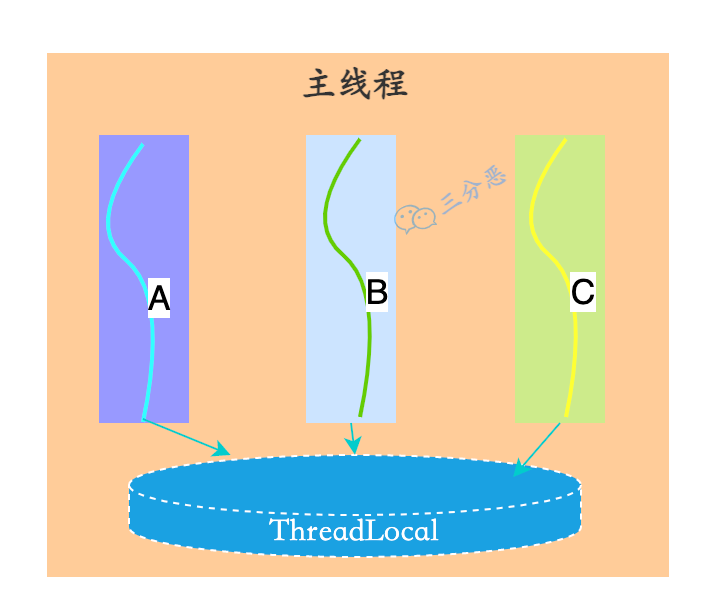
ThreadLocal
public class ABC10 {
public static void main(String[] args) {
//使用ThreadLocal存储变量
ThreadLocal threadLocal = new InheritableThreadLocal();
threadLocal.set(1);
new Thread(() -> {
System.out.println("A");
}, "A").start();
//设置变量值
threadLocal.set(2);
new Thread(() -> {
//等待
while (threadLocal.get() != 2) {
}
System.out.println("B");
}, "B").start();
threadLocal.set(3);
new Thread(() -> {
while (threadLocal.get() != 3) {
}
System.out.println("C");
}, "C").start();
}
}
11.管道流PipedStream
线程之间通信,还有一种比较笨重的办法——PipedInputStream/PipedOutStream。
一个线程使用PipedOutStream写数据,一个线程使用PipedInputStream读数据,而且Piped的读取只能一对一。
那么,在这道题里:
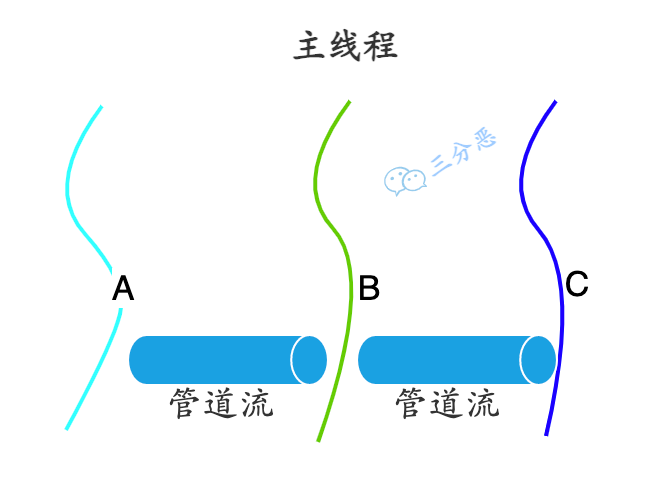
管道流
public class ABC11 {
public static void main(String[] args) throws IOException {
//线程A的输出流
PipedOutputStream outputStreamA = new PipedOutputStream();
//线程B的输出流
PipedOutputStream outputStreamB = new PipedOutputStream();
//线程B的输入流
PipedInputStream inputStreamB = new PipedInputStream();
//线程C的输入流
PipedInputStream inputStreamC = new PipedInputStream();
outputStreamA.connect(inputStreamB);
outputStreamB.connect(inputStreamC);
new Thread(() -> {
System.out.println("A");
try {
//流写入
outputStreamA.write("B".getBytes());
} catch (IOException e) {
e.printStackTrace();
}
}, "A").start();
new Thread(() -> {
//流读取
byte[] buffer = new byte[1];
try {
inputStreamB.read(buffer);
//转换成String
String msg = new String(buffer);
System.out.println(msg);
outputStreamB.write("C".getBytes());
} catch (IOException e) {
e.printStackTrace();
}
}, "B").start();
new Thread(() -> {
byte[] buffer = new byte[1];
try {
inputStreamC.read(buffer);
String msg = new String(buffer);
System.out.println(msg);
} catch (IOException e) {
e.printStackTrace();
}
}, "C").start();
}
}
12.阻塞队列BlockingQueue
阻塞队列同样也可以用来进行线程调度。
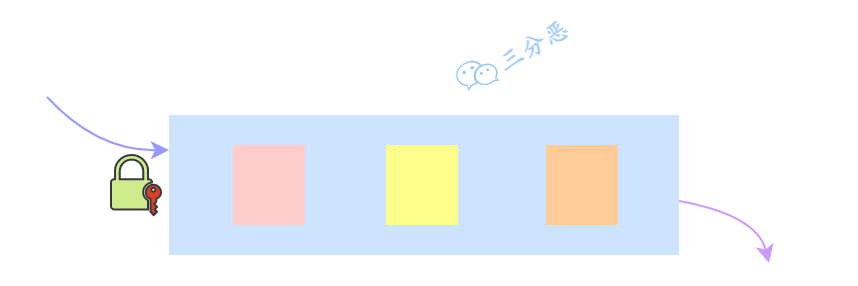
阻塞队列
public class ABC12 {
private static BlockingQueue queue = new ArrayBlockingQueue(3);
public static void printA() {
System.out.println("A");
queue.offer("B");
}
public static void printB() throws InterruptedException {
while (queue.size() != 1) {
}
System.out.println("B");
queue.offer("C");
}
public static void printC() throws InterruptedException {
while (queue.size() != 2) {
}
System.out.println("C");
}
}
总结
这篇文章给大家带来了三个线程顺序打印ABC的的十二种做法,里面有些写法肯定是冗余的,大家有没有什么更好的写法呢?
通过十二种题解,我们基本上把Java并发中主要的线程同步和通信方式过了一遍,相信通过这道题的实践,我们也能对Java线程的同步和通信有更深的理解。
最后,也给大家留两道“进阶”一点的题目,感兴趣可以自己实现一下:
号外!号外!
Java 极客技术微信群中有很多优秀的小伙伴在讨论技术,偶尔还有不定期的资料分享和红包发放!如果你想提升自己,并且想和优秀的人一起进步,感兴趣的朋友,可以在下方公众号后台回复:加群。
限 时 特 惠: 本站每日持续更新海量各大内部创业教程,一年会员只需98元,全站资源免费下载 点击查看详情
站 长 微 信: lzxmw777



